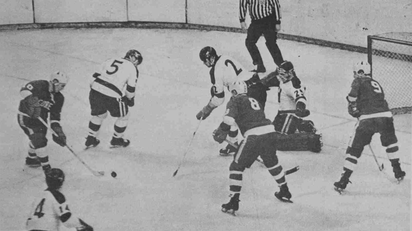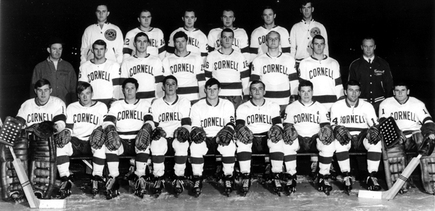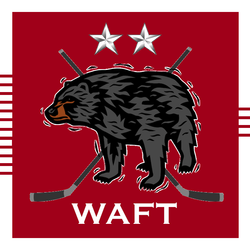A very talented core surrounded Dryden and ensured his success. No individual player guaranteed the success that Cornell had enjoyed in the 1966-67 and 1967-68 seasons. However, the loss of a student-athlete who had gained near legendary status during his two previous years with the varsity squad scarcely can be overstated.
Cornell began preparations for the season with more precision and earlier than it had during the five previous season under Harkness. Harkness was consistent in claiming that his team was further in its development than it had been during the previous two championship seasons. Cornell returned nine of its top-ten scorers from the previous season. The lone departure from the 1967-68 team was captain and defenseman Stanowski who checked in as the tenth-most prolific scorer of the 1967-68 team.
The carnelian and white had a great deal to be excited about as they returned not only seasoned players, but added new talent from the freshman team. Anchoring that talent was Brian McCutcheon. He dazzled the Faithful with a hat trick in his first outing with the varsity squad during an exhibition game at Lynah Rink.
Dryden and Cornell began their 1968-69 ECAC campaign far from the way that they had hoped. Cornell's first opponent was Harkness' former team, the Engineers of RPI. RPI head coach Garry Kearns and the Engineer fans at Houston Field House were overcome with excitement and cheers of "we're number one" when Engineer Doug Hearns bested Dryden in overtime for the game-winning tally. Many within the RPI program remember the game as the victory that preserved the program in an era when its future was highly tenuous. The loss was Dryden's second loss to an ECAC program in his career. It would be the last.
Cornell rebounded with back-to-back wins against Brown and Yale by a margin of ten goals scored to three allowed. The first half of the season ended with Big Red victories over New Hampshire, Boston College, and Minnesota-Duluth. Cornell was back on track and living up to its preseason ranking as the best team in the nation.
Cornell picked up the second half of the season where it left off in December. Cornell went undefeated during the run-up to the 1969 ECAC Tournament. Cornell amassed a record of 23-1-0 before the playoffs began. The success of the 1968-69 Cornell team guaranteed it the first seed in the 1969 ECAC Tournament. The eighth-seeded St. Lawrence Saints would pose the first test for Cornell as it attempted to solidify its dominance in the ECAC further.
The clash between Cornell and the Saints pitted the program that had set itself above all other programs in the ECAC with winning two ECAC Championships against the program that won the inaugural ECAC Championship. The game resulted in Cornell's second-ever shutout in the ECAC Tournament.
The Lynah Faithful welcomed St. Lawrence to Lynah Rink. The seniors would bid adieu to their raucous fans in spectacular fashion. Brian Cornell sprained his ankle during the contest and was forced to leave the game. Even though the night served to commemorate the seniors and the success that they had brought Cornell, it was sophomore Kevin Pettit who scored two power-play goals and junior Dan Lodboa who propelled Cornell to a 3-0 victory. Dryden was flawless with a shutout on 32 shots during his final performance in front of the Lynah Faithful.
A familiar foe awaited Cornell at Boston Garden. It would be the fourth consecutive meeting of Boston University and Cornell in the postseason. The teams had met in the 1967 ECAC Championship Final, 1967 NCAA Tournament Final, and the 1968 ECAC Championship Semifinal. All three of those contests had been decided in Cornell's favor. The fourth meeting yielded the same result.
Brian Cornell announced that he would return to the Big Red's lineup during the run-up to the semifinal clash. The media buzzed with the story that he was chasing Doug Ferguson's single-season point record. Doug Ferguson had amassed 71 points during the 1965-66 season when he captained the Big Red to an ECAC Championship Final appearance. Brian Cornell with 70 points headed to Boston Garden as captain with hopes of doing more than one better than had Doug Ferguson.
Cornell's offense was lethargic at times during the ECAC Championships weekend in 1969. Dryden lived up to his legend during his last stand at Boston Garden. Dan Lodboa and Bruce Pattison provided the needed reinforcement for Dryden behind the blue line.
Boston University and Cornell held each other in check for the first 16 minutes of the 1969 ECAC Championship Semifinal. The nearly 2,000 Lynah Faithful who made the trip to Boston Garden for the Friday clash would not need to wait much longer to learn if Brian Cornell would equal the season point total of Doug Ferguson. Dan Lodboa took a blast of a shot that Brian Cornell directed into the Terriers's net for a 1-0 lead and Brian Cornell's 71st point of the 1968-69 season.
Cornell would leave the ice for the second intermission with a 2-0 leads. Dryden would be called upon to make 17 saves in the second period alone. His defensemen and he were more than equal to all of Boston University's threats. Boston University's McCann rose to the challenge of a goalie duel with Dryden in the third period.
The Terriers were not about to go quietly. Boston University's Herb Wakabayashi and Serge Bily connected to best Dryden at 3:08 of the third period. McCann stood tall and held off the Red onslaught. The valiant efforts of the Terriers's netminder left Cornell desperate. Cornell forwards began to press and Cornell defensemen began to pinch. The "Cornell hockey machine" surrendered several dangerous opportunities. Wakabayashi found Eddie Wright in front of the Cornell net that was left spatially vacant save for Dryden due to Cornell's overzealous offense.
Boston University knotted the game. The contingent of nearly 11,000 fans in Boston Garden that Terrier fans dominated erupted. The eruption was taxing on the Cornell squad that faced a new game with less than ten minutes remaining in the third period. Harkness needed to call his timeout. He needed his skaters to rededicate to their playoff precision rather than a foolhardy "playoff psyche."
The partisan Boston University fans were obliged to help the visitors from East Hill. Harkness would not need to call his timeout. A deluge of detritus rained down upon the ice. Terrier fans in their glee of getting the game-tying tally against the unsolvable Dryden had tossed arena garbage and paraphernalia on the ice.
The rink crew went to removing the litter from the ice. Harkness took advantage of the time to right the course of his squad.
Cornell regained its composure in all zones of the ice. Cornell could not solve McCann in regulation, but Cornell's commitment to defense reemerged. Cornell had fought back from the ropes. The next tally would win the game.
Cornell had played only one game in overtime in the ECAC Tournament. Cornell lost that game to Brown in March 1965. Cornell would not wait long to prove that overtime was not where Cornell's hopes of dominance went to die.
Cornell leapt on the puck early in the extra frame. Boston University had possession of the puck behind its own net. A Terrier forward attempted to pass the puck up ice from behind the net. The pass did not connect. Pettit intercepted the pass between the face-off circles in front of the resilient McCann. The Boston University netminder was not up to the task. Pettit ended the game 31 seconds into overtime with a final score of 3-2.
The 1969 ECAC Championship Final hosted the first postseason clash between Cornell and Harvard. The rivalry that existed between Boston University and Cornell that had been played out the previous evening was between two sports programs that had developed animosity on the ice. The Cornell-Harvard rivalry had been played for nearly six decades and involved institutional as well as athletic animosity between the respective universities. Harvard held a 17-13-0 all-time record against Cornell. Cornell had not lost to the Crimson since December 1966.
Cornell had outscored the Crimson by a ratio of two to one during the 1968-69 season. The game at Boston Garden on March 8, 1969 seemed as though it would go similarly. Cornell dominated early and took a 2-0 lead in the opening minutes of the game. Taking an easy and early lead against Cornell's Ivy-League archrival was detrimental to Cornell's discipline. Cornell committed several penalties and afforded the Crimson a chance to battle back into the game.
Cornell killed off the first of the series of penalties with relative ease. Harvard struck iron on that power-play opportunity, but Cornell's defense and Dryden were up to the challenge in front of the crowd of 11,000 at Boston Garden. The second penalty of the series was called against critical Cornell defenseman Dan Lodboa.
Cornell killed that penalty. A Harvard forward took a questionable hit on Cornell's Ted Coviello. The Big Red objected. An on-ice brawl ensued. When the bodies and emotions abated momentarily, it was Cornell that would be forced to skate lacking a man. It would not be long until another penalty was called against Cornell. Dryden and three of his Red skaters would need to kill off a two-man Cantab advantage.
The spectacular penalty killing of Cornell, especially the athletics of Dryden, won over the crowd at Boston Garden. However, as the partisan support in the arena began to favor Cornell, the ice began to tilt in Harvard's favor. Cornell successfully killed of the two-man advantage and the remaining penalty after it. Harvard redirected a rebound behind a committed Dryden that put the Crimson on the scoreboard. The remaining six minutes of the second period would expire without any further scoring.
Cornell was clinging to a 2-1 lead as the third period began. Harvard dominated. The clenching grip of the Big Red was not strong enough. The Crimson tied the game less than two minutes into the final stanza. Again a rebound bested Dryden.
Cornell needed to regroup but no downfall of debris would give Harkness the opportunity to remotivate his team. The Red skaters would need to do it on their own. On the ice. Dryden committed to playing a flawless game for however long the game may last. Cornell's defense began to play responsibly.
Cornell's break came on a Big Red rush on Harvard's net. Brian Cornell, Pete Tufford, and Kevin Pettit were on the rush. The scramble resulted in Harvard's netminder, Bruce Durno, losing his stick. Cornell was relentless. This was the time for "the Cornell hockey machine" to strike and deny Ivy-League archrival Harvard its first ECAC Championship. Durno warded off many salvos from the pressing and opportunistic Red.
A fortuitous rebound found itself on the tape of Pettit's stick. The sophomore buried the puck in the right corner of the net out of reach of a diving Durno. The goal would stand. Pettit scored his second game-winning goal in as many days. Cornell would win its third ECAC Championship by defeating Harvard in the first postseason meeting between the Big Red and the Crimson.
The importance of the win was captured well in Dryden's reactions after the game. The usually dispassionate and levelheaded Dryden atypically skated the length of the ice to join his celebrating teammates after Pettit's goal with 2:53 remaining in the game. Dryden remarked he "was [] glad that he got that one. I sure didn't want another overtime."
An empty-net tally from Brian Cornell made the final score 4-2.
Kevin Pettit notched the championship-winning goal. Dryden produced his best performance in the ECAC Tournament with a goals-against average of 1.33 and save percentage of 0.963. Cornell outscored its opponents ten goals to four goals during the 1969 ECAC Tournament. Cornell extended its dominance over the Conference with an unprecedented third ECAC Championship.
Bob Aitchison, Dick Bertrand, Brian Cornell (C), Ted Coviello, Brian Cropper (G), Ken Dryden (G), Bill Duthie, Rick Fullan, Steve Giuliani, Frank Grace, John Hughes, Dan Lodboa, Gordie Lowe, Bill Mackay, Brian McCutcheon,
Bob McGuinn (A), Ian Orr, Bruce Pattison (C), Bill Perras, Kevin Pettit, Garth Ryan, Pete Tufford
- Navigate the Rafters -










 RSS Feed
RSS Feed
